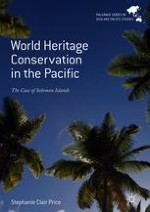2018 | OriginalPaper | Chapter
4. The Protection of Pacific Island Heritage Through the World Heritage Convention Regime
Author : Stephanie Clair Price
Published in: World Heritage Conservation in the Pacific
Publisher: Springer Singapore
Activate our intelligent search to find suitable subject content or patents.
Select sections of text to find matching patents with Artificial Intelligence. powered by
Select sections of text to find additional relevant content using AI-assisted search. powered by
